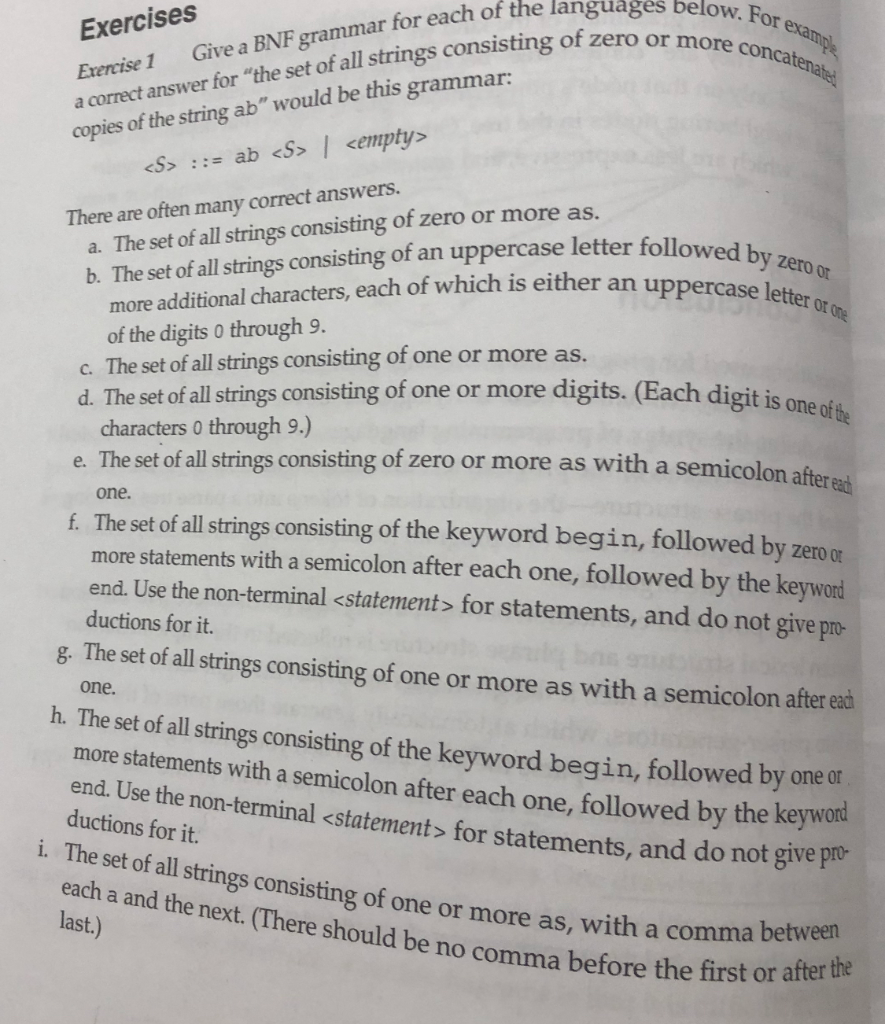(Solved) : Please Answer Exercise 2 Using Questions Exercise 1 Need Answer B C F G J Upvote Answer Q43933017 . . .
Please answer exercise 2 using the questions from exercise 1. Ionly need the answer to B, C, F, G, I, J.
I WILL UPVOTE ANSWER! 

Exercise 2 Give an EBNF grammar for each of the languages of Exercise 1. Use the EBNF extensions wherever possible to simplify the grammars. In particular, you should eliminate explicit recursion from the grammars wherever possible. Don’t forget to put single quotes around any EBNF metasymbol when using it as a token. . Cinemto discomfornach of the languages of Exercise 1. Use 11a AS e languages below. For e w. For example zero or more concatenas Exercises Exercise 1 Give a BNF grammar for each of the langu a correct answer for the set of all strings consisting of zero copies of the string ab” would be this grammar: <S> ::= ab <S> | <empty> or followed by zero or – an uppercase letter or one There are often many correct answers. a. The set of all strings consisting of zero or more as. b. The set of all strings consisting of an uppercase letter follow more additional characters, each of which is either an uppe of the digits 0 through 9. C. The set of all strings consisting of one or more as. Each digit is one of the d. The set of all strings consisting of one or more digits. (Each digit is characters 0 through 9.) e. The set of all strings consisting of zero or more as with a semicolon after one. f. The set of all strings consisting of the keyword begin, followed by zero on more statements with a semicolon after each one, followed by the keyword end. Use the non-terminal <statement> for statements, and do not give pro- ductions for it. g. The set of all strings consisting of one or more as with a semicolon after each one. h. The set of all strings consisting of the keyword begin, followed by one of more statements with a semicolon after each one, followed by the key end. Use the non-terminal <statements for statements, and do not ductions for it i. The set of all strings consisting of one or more as, W each a and the next. (There should be no comma before the sisting of one or more as, with a comma between last.) comma before the first or after the Show transcribed image text Exercise 2 Give an EBNF grammar for each of the languages of Exercise 1. Use the EBNF extensions wherever possible to simplify the grammars. In particular, you should eliminate explicit recursion from the grammars wherever possible. Don’t forget to put single quotes around any EBNF metasymbol when using it as a token. . Cinemto discomfornach of the languages of Exercise 1. Use 11a AS
e languages below. For e w. For example zero or more concatenas Exercises Exercise 1 Give a BNF grammar for each of the langu a correct answer for the set of all strings consisting of zero copies of the string ab” would be this grammar: ::= ab | or followed by zero or – an uppercase letter or one There are often many correct answers. a. The set of all strings consisting of zero or more as. b. The set of all strings consisting of an uppercase letter follow more additional characters, each of which is either an uppe of the digits 0 through 9. C. The set of all strings consisting of one or more as. Each digit is one of the d. The set of all strings consisting of one or more digits. (Each digit is characters 0 through 9.) e. The set of all strings consisting of zero or more as with a semicolon after one. f. The set of all strings consisting of the keyword begin, followed by zero on more statements with a semicolon after each one, followed by the keyword end. Use the non-terminal for statements, and do not give pro- ductions for it. g. The set of all strings consisting of one or more as with a semicolon after each one. h. The set of all strings consisting of the keyword begin, followed by one of more statements with a semicolon after each one, followed by the key end. Use the non-terminal
Expert Answer
Answer to Please answer exercise 2 using the questions from exercise 1. I only need the answer to B, C, F, G, I, J. I WILL UPVOTE …
OR